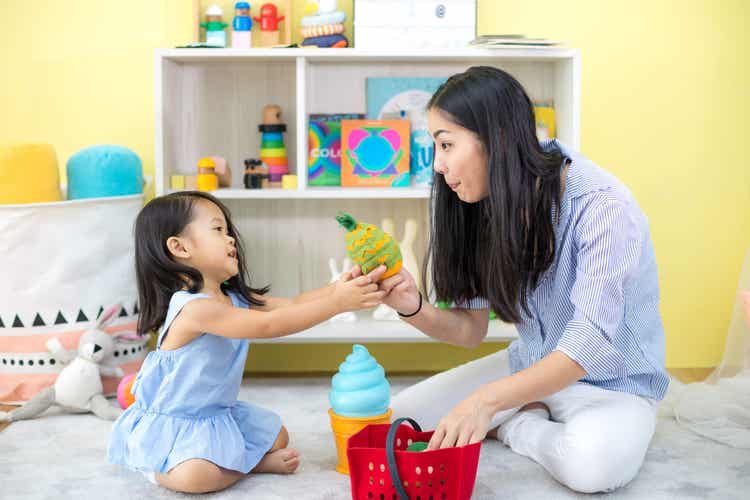7 Ideas to Stimulate Language Through Games

Games become an effective tool, both recreational and educational, when they help to stimulate certain areas of development in little ones, like language. In today’s article, we’ll show you how you can stimulate language through games.
Linguistic abilities in the first years of life are very important. Why? Because that’s when children start to communicate with the environment and learn how to express themselves. As a result, they develop other capacities and abilities, such as socialization.
Stimulate language through games
The games that we’ll show you to help stimulate language are aimed especially at the younger age groups (between 3 and 5 years old). However, they can be adapted to older children by adding other elements and increasing their levels of complexity. As you know, when it comes to education, imagination is power!

1. I hear or I don’t hear
For this game, you can use any toy that you have at home that has pieces you can insert. Some examples are beach rings, tic-tac-toe, a piggy bank, etc.
Then, your child needs to place a token, piece or object next to their ear. From there, any time they hear you making a noise, without seeing you, they should place the object into its slot. This is a good game to work on two aspects of language: auditory information processing and auditory attention. It’s ideal for children under 3 years old.
2. I want I want
Another idea (which is more of an action than a game) to help stimulate language through games in little ones is the following task: every time they want something, they have to choose between two or more options.
For example: “Do you want yogurt or a glass of milk?” By doing that, you’re “forcing” your child to communicate what they want. They could do this by pointing to it or even by making sounds or speaking if they are able to.
You can include this habit in your daily communication with your child. In addition, you can add in toys or small treats in order to keep their attention. In doing so, you’re working on their cognitive abilities, which will help with many other skills – like language.
3. Imitation
Imitation of symbolic roles is a strategy that can help little ones acquire manipulative skills. Also, it allows them to continue learning about the world by playing a game with things that are both real and imaginary.
For this game, you’ll ask your child to imitate certain actions, like talking on the phone, eating, etc. Then, you’ll try to guess what or who they’re imitating. After you guess, you’ll reverse the roles: let them guess what you’re doing. In addition, you and your child can try adding in objects when imitating.
4. I spy
This is a classic game that will help stimulate your child’s language abilities. It consists of selecting an object from the environment (without saying what it is) and having your child try to guess it. In order to do so, they’ll ask questions like: “Is it blue? Can it be eaten? Is it big?”
Then, you can change roles and your child will be the one who picks the object and you who has to guess. This simple game allows you to work on attention, stimulation and oral language, among other skills.
5. The suitcase game, one of the best ways to stimulate language through games
Another fun game that you can use to stimulate language is the suitcase game. This game will test your little one’s memory and attention. Also, it’s a cumulative turn-based game where you’re asked to remember what other players said before you. Ideally, you want to play in groups of 4 or 5 people.
To play, one person starts by saying, “In the suitcase, I’m packing socks,” and the next person has to repeat the same phrase, but then add another item: “In the suitcase, I’m packing socks and a hat,” and so on.
6. Look at me
This one is actually more than a game. The goal is to do an action that will stimulate your child’s attention. It consists of capturing your little one’s attention by making eye contact while you’re doing an action. For example, you can say, “This is a tambourine, look at how I play it.”
In addition, you can make it into a game for very young children. How? Pick their favorite toy that makes a noise. Then, sit in front of them so they can make eye contact with you.

Afterwards, put the toy close to their face (at eye level) and show it to them in a fun and surprising way: “Look at this amazing toy!” When your child looks at you, use positive reactions like kisses, praise and anything else they like to show they did a great job.
7. Magic bubbles, another way to stimulate language through games
This is a variant of the previous game. For this one, you’ll use a stick that you blow bubbles out of. Then, you’ll follow the same steps as in the previous game in order to capture your child’s attention. As soon as they look you in the eye, you should blow a bubble. If they don’t, then you won’t blow any bubbles.
This game is very amusing for children. In addition, you can use music and add other variations, like only blowing bubbles when the music stops.
As you can see, there are multiple ways to stimulate your little one’s language through play: with imitation, objects and toys, sounds, music, etc. Also, you can use a lot of other tools, like stuffed animals, drawings, different actions, etc.
Through these activities, you can work on the smallest aspects of their language: comprehension, expression, verbal and non-verbal language, etc. The important thing is to adapt to their developmental stage and interests. And, above all, you all should be enjoying a fun time with your family! Playing and learning are perfectly compatible actions and they enhance each other.
Games become an effective tool, both recreational and educational, when they help to stimulate certain areas of development in little ones, like language. In today’s article, we’ll show you how you can stimulate language through games.
Linguistic abilities in the first years of life are very important. Why? Because that’s when children start to communicate with the environment and learn how to express themselves. As a result, they develop other capacities and abilities, such as socialization.
Stimulate language through games
The games that we’ll show you to help stimulate language are aimed especially at the younger age groups (between 3 and 5 years old). However, they can be adapted to older children by adding other elements and increasing their levels of complexity. As you know, when it comes to education, imagination is power!

1. I hear or I don’t hear
For this game, you can use any toy that you have at home that has pieces you can insert. Some examples are beach rings, tic-tac-toe, a piggy bank, etc.
Then, your child needs to place a token, piece or object next to their ear. From there, any time they hear you making a noise, without seeing you, they should place the object into its slot. This is a good game to work on two aspects of language: auditory information processing and auditory attention. It’s ideal for children under 3 years old.
2. I want I want
Another idea (which is more of an action than a game) to help stimulate language through games in little ones is the following task: every time they want something, they have to choose between two or more options.
For example: “Do you want yogurt or a glass of milk?” By doing that, you’re “forcing” your child to communicate what they want. They could do this by pointing to it or even by making sounds or speaking if they are able to.
You can include this habit in your daily communication with your child. In addition, you can add in toys or small treats in order to keep their attention. In doing so, you’re working on their cognitive abilities, which will help with many other skills – like language.
3. Imitation
Imitation of symbolic roles is a strategy that can help little ones acquire manipulative skills. Also, it allows them to continue learning about the world by playing a game with things that are both real and imaginary.
For this game, you’ll ask your child to imitate certain actions, like talking on the phone, eating, etc. Then, you’ll try to guess what or who they’re imitating. After you guess, you’ll reverse the roles: let them guess what you’re doing. In addition, you and your child can try adding in objects when imitating.
4. I spy
This is a classic game that will help stimulate your child’s language abilities. It consists of selecting an object from the environment (without saying what it is) and having your child try to guess it. In order to do so, they’ll ask questions like: “Is it blue? Can it be eaten? Is it big?”
Then, you can change roles and your child will be the one who picks the object and you who has to guess. This simple game allows you to work on attention, stimulation and oral language, among other skills.
5. The suitcase game, one of the best ways to stimulate language through games
Another fun game that you can use to stimulate language is the suitcase game. This game will test your little one’s memory and attention. Also, it’s a cumulative turn-based game where you’re asked to remember what other players said before you. Ideally, you want to play in groups of 4 or 5 people.
To play, one person starts by saying, “In the suitcase, I’m packing socks,” and the next person has to repeat the same phrase, but then add another item: “In the suitcase, I’m packing socks and a hat,” and so on.
6. Look at me
This one is actually more than a game. The goal is to do an action that will stimulate your child’s attention. It consists of capturing your little one’s attention by making eye contact while you’re doing an action. For example, you can say, “This is a tambourine, look at how I play it.”
In addition, you can make it into a game for very young children. How? Pick their favorite toy that makes a noise. Then, sit in front of them so they can make eye contact with you.

Afterwards, put the toy close to their face (at eye level) and show it to them in a fun and surprising way: “Look at this amazing toy!” When your child looks at you, use positive reactions like kisses, praise and anything else they like to show they did a great job.
7. Magic bubbles, another way to stimulate language through games
This is a variant of the previous game. For this one, you’ll use a stick that you blow bubbles out of. Then, you’ll follow the same steps as in the previous game in order to capture your child’s attention. As soon as they look you in the eye, you should blow a bubble. If they don’t, then you won’t blow any bubbles.
This game is very amusing for children. In addition, you can use music and add other variations, like only blowing bubbles when the music stops.
As you can see, there are multiple ways to stimulate your little one’s language through play: with imitation, objects and toys, sounds, music, etc. Also, you can use a lot of other tools, like stuffed animals, drawings, different actions, etc.
Through these activities, you can work on the smallest aspects of their language: comprehension, expression, verbal and non-verbal language, etc. The important thing is to adapt to their developmental stage and interests. And, above all, you all should be enjoying a fun time with your family! Playing and learning are perfectly compatible actions and they enhance each other.
All cited sources were thoroughly reviewed by our team to ensure their quality, reliability, currency, and validity. The bibliography of this article was considered reliable and of academic or scientific accuracy.
- Costa, Inês, Ramos, Ana Margarida, & Brondo, Elsa R. (2021). Literatura sin palabras: el caso de los libros-álbum sin texto. Acta poética, 42(1), 69-86. Epub 03 de marzo de 2021. Disponible en: https://doi.org/10.19130/iifl.ap.2021.1.886
- Pérez, M. (2004). Desarrollo del lenguaje. En J. Palacios, A., Marchesi, C. Coll (Eds.), Desarrollo psicológico y educación: Psicología Evolutiva. Madrid: Alianza Editorial.
- Vial, J. (1988). Juegos y educación. Las ludotecas. Madrid: Akal.
This text is provided for informational purposes only and does not replace consultation with a professional. If in doubt, consult your specialist.








